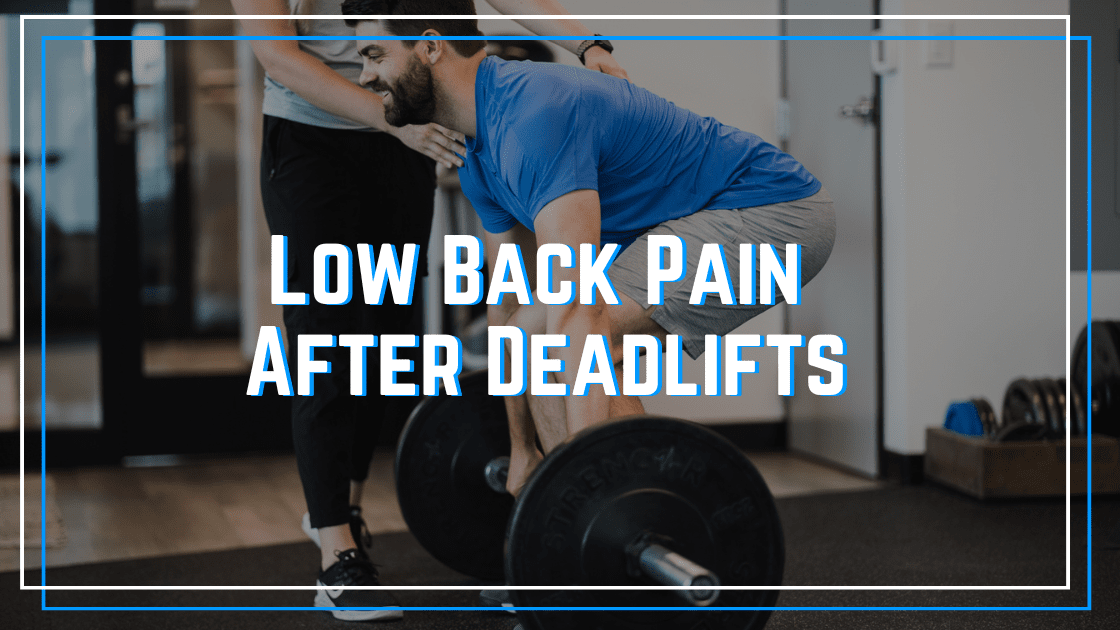The deadlift can be one of the best exercises for building total body strength and improving the health of your spine. But many athletes get recurring low back pain after deadlifts. If that is you, then we will share the most common causes of this to help you get past deadlifts being an aggravating activity.
Low Back Pain After Deadlifts Cause #1 – Low Back Weakness
One of the most common issues I see in individuals with low back pain after deadlifts is inadequate lower back strength. The deadlift requires a strong leg drive off the ground, hamstring and glute power to finish the lift, and lumbar spine strength throughout the entire movement. These muscles get overloaded when an athlete with stronger legs relative to their back deadlifts, and the back gets achy.
Unfortunately, there isn’t any one great test for assessing leg vs. low back strength. So I tend to rely on the combination of these three things:
- Athletes with a relatively low deadlift compared to their squat. Most athletes will have a strength ratio where the squat is 80% of their deadlift. If the squat is significantly higher, the back is a bit weaker. Download our strength ratio assessment tool here!
- Athletes that are fast out of the hole in the squat but quickly hit a brick wall and their spine rounds forward, and the lift is missed.
- Individuals that cannot perform a 2-minute Sorenson hold
If you think, based on the above, that lower back strength is a component of your deadlift issues, our Bulletproof Back Builder program is meant for you!
Lack of Lat Engagement
Another common issue leading to low back pain after deadlifts is lack of lat engagement. The lats work to control where the barbell hangs. The bar will drift away from the body if we don’t know how to use them in the deadlift. This increases the moment arm on the hips and leads to more load being placed on the back.
The following video shows what a lat engaged deadlift looks like (left) vs. not. Notice the space between the body and the barbell.
View this post on Instagram
Poor Leg Drive Off the Ground
While the deadlift is usually categorized as a lower body pulling exercise, it is essential to note that a strong leg drive should be the initiation of the lift. Martin-Fuentes and colleagues found EMG activity of the quads to be higher than the glute max in the deadlift, illustrating the importance of a leg drive.
When athletes don’t get a good leg drive, we tend to see one of two things (illustrated in the below video)
- The hips shoot up fast, turning the deadlift into a straight-leg deadlift.
- The barbell travels forward off the ground. This especially happens when athletes have a lower set-up position and then don’t get a good quad drive
View this post on Instagram
Poor Bracing Strategy
The next issue we will see in athletes dealing with recurring low back pain after deadlifts is poor spinal bracing. Bracing is crucial to increased abdominal pressure, which stiffens the spine for heavy lifting. If you aren’t familiar with proper spine bracing, this article will help you out.
Overall Program Design and Recovery Balance
The final cause of low back pain after deadlifts has nothing to do with technique. That is poor program design and inadequate recovery. And it might be the most common cause we’ll discuss in this article.
Often, I see athletes with low back pain after deadlifts that report only practicing the lift every few months. As a result, they don’t develop technical efficiency or train the tissues to be prepared for that movement. They then jump into a heavy or high-volume deadlift workout and re-tweak their lower back.
On the other hand, is athletes that don’t pay attention to their recovery enough. When we train in any fitness aspect, tissues are broken down, and the body repairs that breakdown and makes the tissues more robust than before that workout. This is called the principle of Stimulus, Recovery, and Adaptation. The deadlift is perhaps the most highly taxing movement you can train. And if your sleep & nutrition isn’t on par, it makes rebuilding the tissues broken down from training much more difficult.






